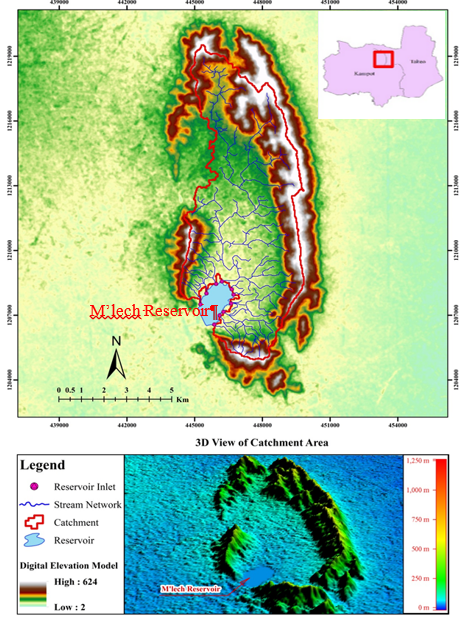The Study on Water Balance in Mlech Reservoir Under Climate Change Effects, Kampot Province
DOI:
https://doi.org/10.51264/inajl.v3i1.25Keywords:
Climate Change, Mlech Reservoir, Rational Method, Streamflow, Water BalanceAbstract
The Mlech Water Treatment Plant (WTP) has produced 2,000 m3/day of drinking water using raw water from Mlech, Kampot province. Since water demand would be increased in the future, so that the extension water treatment capacity will be the main challenges in correspondence with the development of planning of PPWSA. The water balance estimation is also the critical point in order to make a good decision on extension WTP at existing area. Therefore, the objectives of this study aimed to analyse the water balance in Mlech reservoir by using data from 2002 to 2011, in 2030s and in 2050s. The Rational Method was applied for estimating the streamflow into the reservoir. Water balance was computed following hydrological concept. SWAT and HEC-HMS models were performed to predict the future streamflow. The future climatic data were projected from 2012 to 2050 under climate change scenario RCP 4.5 with three general circulation models (GCMs) including IPSL-CM5A-MR, GISS-E2-R-CC and GFDL-CM3. As a result, the water balance remains about 11.40 Mm3/year in reservoir in baseline. In 2030s, the water quantity will be approximately 58.70 Mm3/year, 62.09 Mm3/year and 59.58 Mm3/year under model IPSL-CM5A-MR, GISS-E2-R-CC and GFDL-CM3, respectively. In addition, the water quantity will be slightly changed in 2050s comparing to 2030s. According to the scenario of extension WTP capacity, this study found that the water flow into downstream will be decreased to 37.14 Mm3/year to 33.84 Mm3/year when WTP’s capacity increased from 2,000 m3/day to 14,000 m3/day,respectively. Furthermore, the volume of water overflow to downstream for irrigation uses is 30.32 Mm3/year when WTP’s capacity increased to 12,000 m3/day in 2050s. Irrigation water need is about 28.00 Mm3/year. In recommendation, the total WTP’s capacity should be extended from 2,000 m3/day to 10,000m3/day from Mlech reservoir based on the future water demand.
References
Chow, VT, Maidment DR, and Mays LW. 1988. Applied Hydrology. McGraw-Hill Book Company. New York.
Dhar S, and Mazumdar A. 2009. Impacts of climate change under the threat of global Warming for an agricultural watershed of the Kangsabati River. International Journal of Civil and Environmental Engineering, 1 (3), 154-163.
FAO.https://www.fao.org/3/s2022e/s2022e07.htm
Feldman AD. 2000. Hydrologic modeling system HEC-HMS: technical reference manual: US Army Corps of Engineers, Hydrologic Engineering Center
Gupta HV, Sorooshiann S, Yapo PO. 1999. Status of automatic calibration for hydrologic models: Comparison with multilevel expert calibration. Journal of hydrologic Engineering, 4(2), 135-142.
IPCC. 1996a. Climate change 1995: the science of climate change. In: Houghton, John T,Meiro Filho, LG, Callander, Bruce A, Harris, Neil, Kattenburg, Arie, Maskell, Kathy. Climatic change, 584.
Katz RW, and Brown BG. 1992. Extreme events in a changing climate: variability is more important than averages. Climatic change, 21(3), 289-302.
Kumar G, Singh SK, Murari K, Pandey V, Om Prakash, Sinha BK, and Prasad SK. 2012. Quality Assessment and Recharge Potential of Ground Water of Chasnala Coal Mines, A Case Study. Research Journal of Pharmaceutical, Biological and Chemical Sciences, 3(1), 959-968
Minville M, Krau S, Brissette F, and Leconte R. 2010. Behaviour and performance of a water resource system in Québec (Canada) under adapted operating policies in a climate change context. Water Resources Management, 24(7), 1333-1352.
Moriasi DN, Arnold JG, Van Liew MW, Bingner RL, Harmel RD, Veith TL. 2007. Model evaluation guidelines for systematic quantification of accuracy in watershed simulations. Transactions of the Asabe, 50(3), 885-900.
MRC. 2017 Summary of the basin-wide assessments of climate change impacts on water and water related resources in the Lower Mekong Basin.
Nash JE, and Sutcliffe JV. 1970. River flow forecasting through through conceptual models’ part I-A discussion of principles. Journal of Hydrological, 10(3), 282-290.
Neitsch S, Arnold J, Kiniry J, and Williams J. 2001. Soil and Water Assessment Tool-Version 2000-User’s Manual, 2001.
Singh WR, Jain MK. 2015. Continuous Hydrologic Modeling using Soil Moisture Accounting Algorithm in Vamsadhara River Basin, India. Journal of Water Resource and Hydrologic Engineering, 4(4), 398-408.
Vilaysane B, Takara K, Luo P, Akkharath I, Duan W. 2015. Hydrological streamflow modelling for calibration and uncertainty analysis using SWAT model in the Sedone river basin, Lao PDR. Procedia Environmental Sciences, 28, 380-390.

Downloads
Published
Issue
Section
License
Copyright (c) 2022 Indonesian Journal of Limnology

This work is licensed under a Creative Commons Attribution 4.0 International License.






